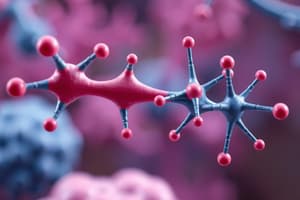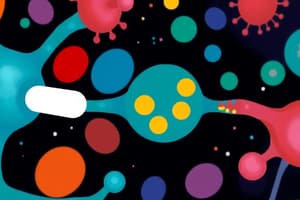Podcast
Questions and Answers
What term is used to describe drugs that stabilize receptors in an inactive conformation?
What term is used to describe drugs that stabilize receptors in an inactive conformation?
- Inverse agonists (correct)
- Chemical antagonists
- Functional antagonists
- Partial agonists
How do partial agonists behave in the presence of a full agonist?
How do partial agonists behave in the presence of a full agonist?
- As selective agonists
- As competitive antagonists (correct)
- As inverse agonists
- As complete agonists
What factor primarily influences the affinity of a drug for its receptor?
What factor primarily influences the affinity of a drug for its receptor?
- The drug's dosing schedule
- The route of administration
- The drug's chemical structure (correct)
- The patient's age
Which drug is known for its low specificity due to interaction with multiple receptors?
Which drug is known for its low specificity due to interaction with multiple receptors?
What is the primary outcome of a drug having high specificity?
What is the primary outcome of a drug having high specificity?
What characteristic of drugs can lead to adverse side effects due to off-target interactions?
What characteristic of drugs can lead to adverse side effects due to off-target interactions?
What defines the intrinsic activity of a drug?
What defines the intrinsic activity of a drug?
Which property of a drug's stereoisomers can vary, affecting its pharmacodynamics?
Which property of a drug's stereoisomers can vary, affecting its pharmacodynamics?
What does the therapeutic index of a drug primarily indicate?
What does the therapeutic index of a drug primarily indicate?
Why is monitoring of clinical and surrogate markers crucial when using the population therapeutic window?
Why is monitoring of clinical and surrogate markers crucial when using the population therapeutic window?
In clinical pharmacology, which statement best describes the role of the route of administration?
In clinical pharmacology, which statement best describes the role of the route of administration?
What is a potential consequence of overlapping concentrations required for therapeutic and toxic effects?
What is a potential consequence of overlapping concentrations required for therapeutic and toxic effects?
Which of the following is true regarding the effects of magnesium sulfate when administered via different routes?
Which of the following is true regarding the effects of magnesium sulfate when administered via different routes?
What effect does the combination of drugs A and B demonstrate if the efficacy is greater than the sum of their individual effects?
What effect does the combination of drugs A and B demonstrate if the efficacy is greater than the sum of their individual effects?
Which statement correctly describes a characteristic of antagonists?
Which statement correctly describes a characteristic of antagonists?
How is the therapeutic index represented in pharmacodynamics?
How is the therapeutic index represented in pharmacodynamics?
What does a quantal concentration-effect curve analyze?
What does a quantal concentration-effect curve analyze?
What describes the condition where the combination of drugs has less efficacy than expected based on their individual effects?
What describes the condition where the combination of drugs has less efficacy than expected based on their individual effects?
Which factor is NOT typically associated with variability in individual drug responsiveness?
Which factor is NOT typically associated with variability in individual drug responsiveness?
What happens to the required concentrations of drugs A and B if they exhibit positive synergism?
What happens to the required concentrations of drugs A and B if they exhibit positive synergism?
What can influence the dynamic nature of drug receptors?
What can influence the dynamic nature of drug receptors?
What is the primary concern regarding the maintenance treatment of heart failure with digoxin in women compared to men?
What is the primary concern regarding the maintenance treatment of heart failure with digoxin in women compared to men?
Which of the following environmental factors is known to influence drug metabolism?
Which of the following environmental factors is known to influence drug metabolism?
What type of tolerance refers to the requirement of higher doses of a drug to achieve the same effect?
What type of tolerance refers to the requirement of higher doses of a drug to achieve the same effect?
Which statement best describes tachyphylaxis?
Which statement best describes tachyphylaxis?
Which of the following drugs is NOT associated with side effects of gynaecomastia or loss of libido in men?
Which of the following drugs is NOT associated with side effects of gynaecomastia or loss of libido in men?
What is the main reason that the L-enantiomer of sotalol is considered more potent than the D-enantiomer?
What is the main reason that the L-enantiomer of sotalol is considered more potent than the D-enantiomer?
What phenomenon occurs with chronic administration of nitro-vasodilators that can impact treatment efficacy?
What phenomenon occurs with chronic administration of nitro-vasodilators that can impact treatment efficacy?
Which of the following describes a characteristic of drug potency?
Which of the following describes a characteristic of drug potency?
What does efficacy refer to in the context of drug-receptor interactions?
What does efficacy refer to in the context of drug-receptor interactions?
Which of the following accurately describes a non-receptor interacting mechanism of drug action?
Which of the following accurately describes a non-receptor interacting mechanism of drug action?
Which principle is the basis of receptor occupancy theory in pharmacology?
Which principle is the basis of receptor occupancy theory in pharmacology?
Which characteristic defines a partial agonist in pharmacology?
Which characteristic defines a partial agonist in pharmacology?
What effect does chronic drug administration commonly have on drug receptors?
What effect does chronic drug administration commonly have on drug receptors?
Study Notes
Antagonism
- Antagonism is the inhibition of the action of a drug by another drug.
- Antagonism can happen in different ways including competitive antagonism, combining with the agonist, or through functional antagonism
- Partial agonists only partially activate receptors.
- Inverse agonists stabilize receptors in an inactive conformation, decreasing their activity.
Drug Selectivity
- The strength of the interaction between a drug and its receptor is called affinity.
- Affinity, along with the intrinsic activity of a drug, is determined by its chemical structure.
- Drugs interacting with a single type of receptor expressed on limited cells exhibit high specificity.
- Drugs acting on ubiquitously-expressed receptors have widespread effects.
- Many drugs exhibit broad (low) specificity, interacting with multiple receptors. This can enhance clinical utility but also lead to adverse effects from "off-target" interactions.
- Amiodarone, used to treat cardiac arrhythmias, exhibits broad specificity, interacting with various receptors and causing toxicities.
- Stereoisomers of a drug can exhibit different pharmacodynamic and pharmacokinetic properties.
Chronic Drug Administration
- Chronic drug administration can cause downregulation of receptors or desensitization, requiring dose adjustments for effective therapy.
- Tachyphylaxis is the rapid development of tolerance to a drug after repeated administration.
Non-receptor Mechanisms
- Some drug effects are not mediated by receptors.
- Aluminum and magnesium hydroxides act chemically to neutralize gastric acid.
- Mannitol acts osmotically to change water distribution, affecting diuresis, catharsis, circulating volume, and cerebral edema.
Receptor Occupancy Theory
- This theory proposes that drug effects arise from the occupation of receptors by the drug, based on the law of mass action.
- Dose-response curves illustrate the relationship between drug concentration and observed effects.
Affinity, Efficacy, and Potency
- Drug-receptor interactions involve binding and generation of a response, with affinity being the measure of the reversible formation of the ligand-receptor complex.
- Potency refers to the relative dose required to achieve a certain effect, with a more potent drug having a lower EC50.
- Efficacy reflects the capacity of a drug to activate a receptor and produce a cellular response.
- Full agonists elicit a full response at some concentration.
- Partial agonists do not elicit a full response, even at high doses.
- Antagonists bind to a receptor without producing a response.
Additivity and Synergism
- Combinations of drugs can achieve additive or synergistic effects.
- Positive synergism results in superadditive effects, allowing reduced concentrations of each drug.
- Negative synergism (subadditive effects) occur when the combined efficacy is less than expected, requiring higher drug concentrations.
Variability in Individual and Population Pharmacodynamics
- Individuals vary in their response to drugs, and the response can change due to disease, age, and prior drug administration.
- Receptor concentrations and functions can be altered by both endogenous and exogenous factors.
Population Variability
- Population pharmacodynamic variability influences the interpretation of data on drug levels with efficacy and toxicity.
Quantal Concentration-Effect Curve
- This curve provides a population-based analysis of pharmacodynamic response, plotting the percentage of individuals experiencing an effect at different drug concentrations.
- The median effective dose (ED50) is the dose producing a specified effect in 50% of the population.
Therapeutic Index and Therapeutic Window
- The therapeutic index (LD50/ED50 ratio) reflects drug selectivity in producing desired effects versus adverse effects.
- The therapeutic window represents the range of drug concentrations providing therapeutic efficacy with minimal toxicity.
- In clinical studies, the therapeutic index evaluates the overlap between concentrations required for therapeutic effects and toxic effects in the population.
- The population therapeutic window, though useful, should be combined with clinical markers for accurate dosage adjustments.
Factors Modifying Drug Action
- Numerous factors influence drug response variability, including:
Route of Administration
- Parenteral administration provides more rapid, pronounced, and predictable effects compared to oral administration.
- Different routes of administration can lead to different drug uses: magnesium sulfate demonstrates distinct effects when administered orally, topically, or intravenously.
Direct Administration
- Direct drug application to tissues achieves localized effects on the skin, mucous membranes, and respiratory tract through aerosol sprays.
Sex
- Sex-specific responses to drugs can occur, with some drugs exhibiting different effects in males and females.
Environmental Factors
- Environmental factors, like exposure to insecticides and tobacco smoke, can alter drug metabolism and responses.
Diet
- Diet type can influence drug absorption.
Tolerance
- Tolerance requires higher doses of a drug to achieve a therapeutic response.
- Tolerance can be natural, acquired, or cross-tolerance (between drugs like alcohol and barbiturates).
- Pharmacokinetic tolerance involves altered drug disposition, while pharmacodynamic tolerance involves cellular changes.
- Tachyphylaxis is rapid tolerance development with repeated doses.
Studying That Suits You
Use AI to generate personalized quizzes and flashcards to suit your learning preferences.
Related Documents
Description
This quiz covers key concepts in pharmacology, focusing on antagonism and drug selectivity. It explores various mechanisms of antagonism, such as competitive and functional antagonism, and the significance of drug affinity and specificity. Test your understanding of how these factors influence drug interactions and clinical outcomes.





